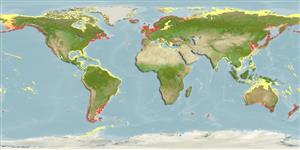Common names from other countries
Environment: milieu / climate zone / depth range / distribution range
Écologie
; saumâtre; profondeur 0 - 60 m (Ref. 7726). Temperate, preferred 9°C (Ref. 107945); 89°N - 58°S, 112°E - 61°E
Circumpolar.
Length at first maturity / Taille / Poids / Âge
Maturity: Lm ? range ? - ? cm Max length : 11.0 cm SHL mâle / non sexé; (Ref. 95344); âge max. reporté: 24 années (Ref. 8702)
Minimum depth (intertidal zone) from Ref. 95344. Inhabits intertidal areas (Ref. 2789). Found in quiet, sheltered areas forming dense aggregates on hard surfaces; attached by strong byssal threads (Ref. 95344). In the Vainameri, north-eastern Baltic Sea, most abundant in silty substrate (Ref. 95753). It is infaunal on sand and eelgrass beds and epifaunal on eelgrass beds (Ref. 95819). Also found on mixed sediments with gravel (Ref. 118257). Semi-mobile suspension feeder (Refs. 95752, 96470). Feeds on phytoplankton such as green algae, dinoflagellates and diatoms (Ref. 95805).
Life cycle and mating behavior
Maturité | Reproduction | Frai | Œufs | Fécondité | Larves
Members of the class Bivalvia are mostly gonochoric, some are protandric hermaphrodites. Life cycle: Embryos develop into free-swimming trocophore larvae, succeeded by the bivalve veliger, resembling a miniature clam.
Harvey-Clark, C. 1997. (Ref. 7726)
Statut dans la liste rouge de l'IUCN (Ref. 130435)
statut CITES (Ref. 108899)
Not Evaluated
Not Evaluated
Utilisations par l'homme
Pêcheries: commercial
FAO - Aquaculture: production, species profile; pêcheries: landings, species profile | FishSource | Sea Around Us
Outils
Sources Internet
Estimates based on models
Preferred temperature
(Ref.
115969): 4.4 - 16.1, mean 10.2 (based on 1512 cells).
Résilience
Haut, temps minimum de doublement de population inférieur à 15 mois (K=0.05-1.14; tmax=24).
Prior r = 0.54, 95% CL = 0.36 - 0.82, Based on 1 data-limited stock assessment.
Vulnérabilité
Moderate vulnerability (36 of 100).
